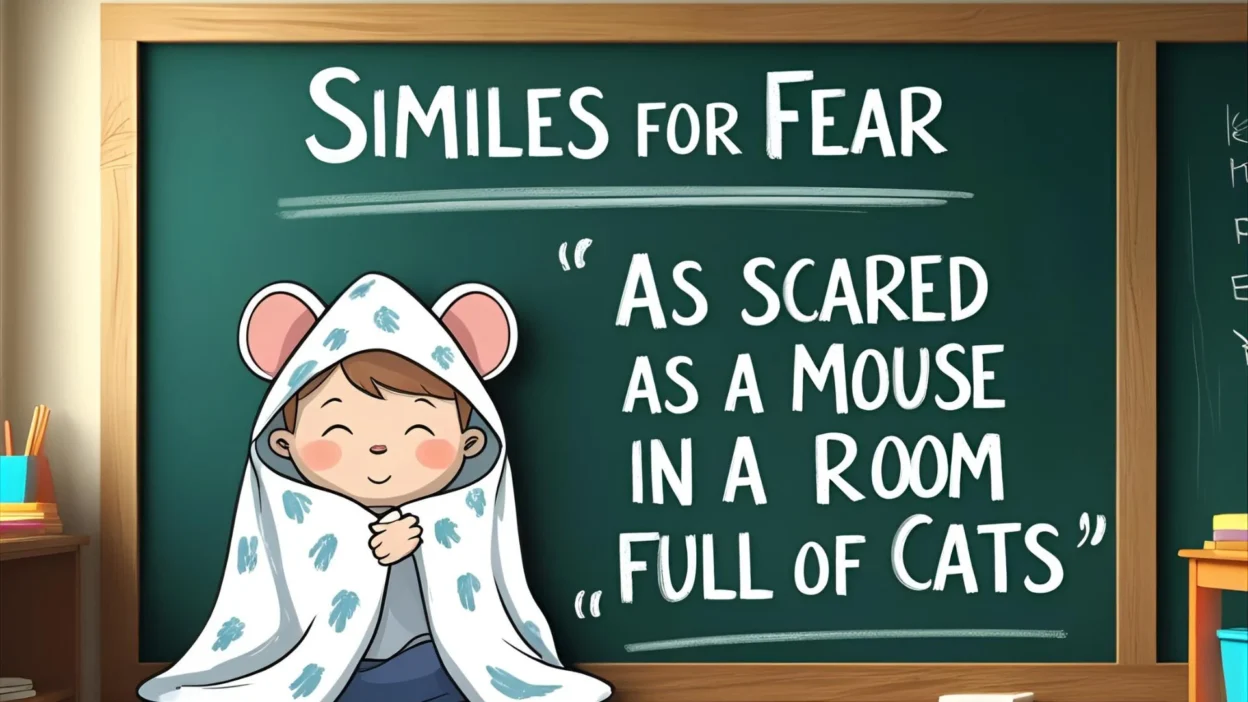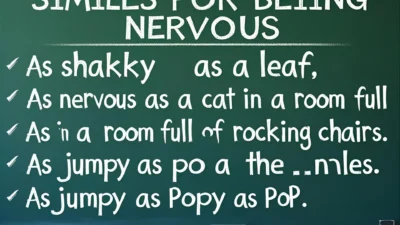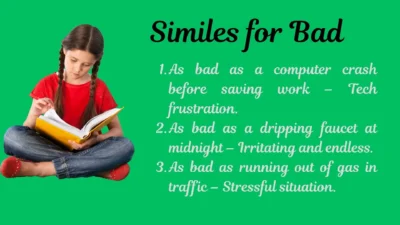Fear is a universal emotion, one we’ve all experienced in various intensities—from the jittery feeling before a big exam to the bone-chilling terror during a horror movie.
Whether you’re a writer, speaker, or student, having the right words to convey fear can elevate your storytelling or expression. That’s where similes come in.
Similes are powerful figures of speech that compare one thing to another using “like” or “as.” In the case of fear, similes help us translate a complex emotional experience into a vivid image the reader or listener can immediately grasp.
This article explores 22+ similes for fear, crafted with real-world context, powerful imagery, and emotional depth.
Let’s dive into the world of fear-based similes—each one polished and backed with examples that reflect 2025-level language trends and creative storytelling.
1. Like a rabbit caught in headlights
This classic simile paints the image of someone frozen in fear, unable to move.
Example:
When the teacher called his name for the oral test, he stood there like a rabbit caught in headlights.
Tone: Suitable for both casual and literary uses; shows paralysis from sudden fear.
2. As if walking on a tightrope over a pit of snakes
This one captures the constant fear and tension of being in a risky or dangerous situation.
Example:
Ever since the scandal, she spoke to the press as if walking on a tightrope over a pit of snakes.
Tone: Vivid, intense, and great for high-stakes storytelling.
3. Like a child hearing thunder for the first time
This simile encapsulates innocent, raw fear—especially when fear is new or surprising.
Example:
He flinched at the explosion like a child hearing thunder for the first time.
Tone: Soft, poetic; perfect for evoking empathy.
4. As nervous as a mouse in a room full of cats
A humorous but effective way to describe someone who feels extremely unsafe or uncomfortable.
Example:
At the interview, he sat as nervous as a mouse in a room full of cats.
Tone: Casual, witty; often used in light-hearted or humorous writing.
5. Like a leaf trembling in the wind
Conveys fear mixed with vulnerability and fragility.
Example:
She approached the door like a leaf trembling in the wind, unsure of what lay beyond.
Tone: Poetic, dramatic; often used in fiction and descriptive prose.
6. Like a ghost had passed through him
This simile suggests a sudden chill or deep, inexplicable fear.
Example:
The moment he heard his name whispered from nowhere, he went pale, like a ghost had passed through him.
Tone: Eerie and mysterious; ideal for horror or suspense writing.
7. As pale as a corpse
This classic simile is used when fear physically drains color from someone’s face.
Example:
She turned as pale as a corpse when she saw the figure outside her window.
Tone: Dark, intense; works well in thriller or gothic contexts.
8. Like a prisoner awaiting his sentence
This simile conveys a fear of inevitable consequences.
Example:
He waited outside the principal’s office like a prisoner awaiting his sentence.
Tone: Somber and relatable; good for both fiction and real-life narratives.
9. As scared as a bird in a thunderstorm
Depicts a character who is small, fragile, and overwhelmed by chaos.
Example:
The child clung to her mother as scared as a bird in a thunderstorm.
Tone: Emotional and visual; great for creating sympathy.
10. Like the walls were closing in on her
This simile expresses claustrophobic fear or anxiety.
Example:
As the deadline neared, she began to feel like the walls were closing in on her.
Tone: Psychological; excellent for describing anxiety-based fear.
Additional Similes for Fear
Now that we’ve explored our top 10 standout examples, here are more expressive similes to diversify your descriptions:
11. As tense as a wire about to snap
Example: He clenched the steering wheel as tense as a wire about to snap during the storm.
12. Like someone watching their shadow move
Example: He glanced behind him, like someone watching their shadow move on its own.
13. As shaky as a candle in the wind
Example: Her voice was as shaky as a candle in the wind when she spoke in court.
14. Like a soldier walking through a minefield
Example: He spoke to his angry boss like a soldier walking through a minefield.
15. As frightened as a fish out of water
Example: Alone in the crowd, she looked as frightened as a fish out of water.
16. Like someone who just saw death’s reflection
Example: His eyes widened, like someone who just saw death’s reflection in the mirror.
17. As timid as a kitten in a thunderstorm
Example: He knocked on the door as timid as a kitten in a thunderstorm.
18. Like a ship bracing for the storm
Example: She held her breath, like a ship bracing for the storm of news that was coming.
19. As frozen as a statue
Example: He stood as frozen as a statue when the snake slithered across his foot.
20. Like a dream turned nightmare
Example: The wedding turned chaotic, like a dream turned nightmare, as the storm hit.
21. As jumpy as popcorn in a skillet
Example: Every small noise made him flinch, as jumpy as popcorn in a skillet.
22. Like a deer surrounded by hunters
Example: Cornered by the press, the celebrity looked like a deer surrounded by hunters.
Nuances of Tone and Context
Not every simile suits every situation. Here’s how to decide:
- Professional writing or academic prose: Choose subtle or poetic similes like “like a leaf trembling in the wind.”
- Fiction or emotional writing: Use vivid similes like “like a ghost had passed through him” or “as pale as a corpse.”
- Humorous or informal tone: Lighter phrases like “as jumpy as popcorn in a skillet” work well.
- Psychological or suspense genres: Darker, intense similes like “like someone who just saw death’s reflection” create gripping imagery.
Tip for writers: Always ask, “What kind of fear am I describing?” Is it sudden, slow-burning, existential, or playful? Match your simile to that.
Why Use Similes to Describe Fear?
Fear is complex. Similes help break it down into relatable, visual moments. Readers connect more when you use:
✅ Familiar imagery
✅ Emotionally charged comparisons
✅ Context-appropriate tone
Whether you’re scripting a novel, pitching a thriller screenplay, or writing a heartfelt blog, similes ground your message in imagery your audience won’t forget.
The Role of Similes in 2025 Writing Trends
In 2025, strong emotional resonance remains a top requirement for standout writing across platforms. Similes help creators:
- Improve SEO by increasing emotional engagement metrics like time-on-page
- Clarify emotions without clinical explanation
- Add rhythm and aesthetic appeal to dialogue and narration
With AI tools and storytelling platforms booming, similes are an underrated weapon for writers seeking original expression.
Final Thoughts
Fear isn’t always screaming or trembling—it can be subtle, silent, or buried deep inside. Similes give you the power to express those nuances vividly.
From “as timid as a kitten in a thunderstorm” to “like someone who just saw death’s reflection,” you now have an arsenal of imagery that can elevate your writing from average to unforgettable.
Use these similes mindfully, match them to your context, and let your language do more than just tell—let it show, stir, and stay with the reader.




